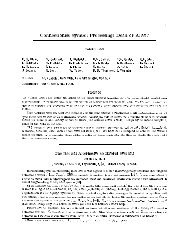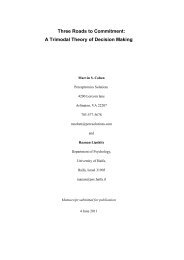Three Roads to Commitment: A Trimodal Theory of Decision Making
Three Roads to Commitment: A Trimodal Theory of Decision Making
Three Roads to Commitment: A Trimodal Theory of Decision Making
Create successful ePaper yourself
Turn your PDF publications into a flip-book with our unique Google optimized e-Paper software.
<strong>Three</strong> <strong>Roads</strong> <strong>to</strong> <strong>Commitment</strong>: A <strong>Trimodal</strong> <strong>Theory</strong> <strong>of</strong> <strong>Decision</strong> <strong>Making</strong> 49<br />
<strong>of</strong> time among competing methods or strategies, including immediate action versus continued decision making. A<br />
variety <strong>of</strong> predictions follow when we classify cognitive strategies by the efficiency with which they achieve<br />
actionable commitment. The three decision modes operate at the second-order level <strong>of</strong> cognitive strategies <strong>to</strong><br />
determine action uncertainty and effort expended.<br />
TDM reframes the notions <strong>of</strong> decision making and uncertainty in a way that is suited for naturalistic research,<br />
decision aiding, and training. On the research side, it <strong>of</strong>fers categories and definitions <strong>to</strong> guide naturalistic<br />
observations, implies empirically testable hypotheses, and brings out similarities and differences among various<br />
decision paradigms. On the application side, it calls for an expanded normative basis and enlarges the function <strong>of</strong><br />
cognitive engineering beyond the supporting role assigned <strong>to</strong> prescription in the standard s<strong>to</strong>ry.<br />
Prescriptive Implications<br />
The TDM framework provides a basis for decision support that is more comprehensive than current variants <strong>of</strong><br />
decision theory, naturalistic decision making, or critical thinking. We will mention a handful <strong>of</strong> high level design<br />
guidelines that are suggested by the framework, which we hope <strong>to</strong> illustrate and elaborate in the future. 22<br />
Compatibility. Our most basic proposition is that decision aids should support modes <strong>of</strong> decision making that<br />
are appropriate for the situation and the decision maker role, according <strong>to</strong> matching. This implies that a traditional<br />
decision model for comparing multiple alternatives should almost never be the default decision aiding mode.<br />
Likewise, support for reassessment should direct attention <strong>to</strong> aspects <strong>of</strong> the current course <strong>of</strong> action that are<br />
permitted <strong>to</strong> change under ethical, organizational, or other constraints. This does not mean that an aid must always<br />
impose an initial phase <strong>of</strong> support for matching (although this may <strong>of</strong>ten be the case). It means that cognitive<br />
engineers must be aware <strong>of</strong> the operation <strong>of</strong> matching and the constraints it imposes on users.<br />
Focus. Displays should direct attention <strong>to</strong> fac<strong>to</strong>rs that are relevant <strong>to</strong> the problem as viewed through the current<br />
mode: i.e., (a) situation awareness, roles, values, and course <strong>of</strong> action creation for matching, (b) comparison <strong>of</strong><br />
outcomes and actions for choice, and (c) course <strong>of</strong> action moni<strong>to</strong>ring, challenging, and modification for<br />
reassessment. For matching, the aid should compare the actual situation with the conditions <strong>of</strong> relevant practices.<br />
For choice, the aid should compare projected action outcomes with desired features across choice alternatives. For<br />
reassessment, the aid should compare actual events and actions with those expected.<br />
22 Some on-going decision aiding work (Cohen et al., 2011; Cohen et al., 2008) works with these principles. A<br />
pro<strong>to</strong>type system has achieved significant acceptance from US Army end users in the field (Weltman et al., 2011).




